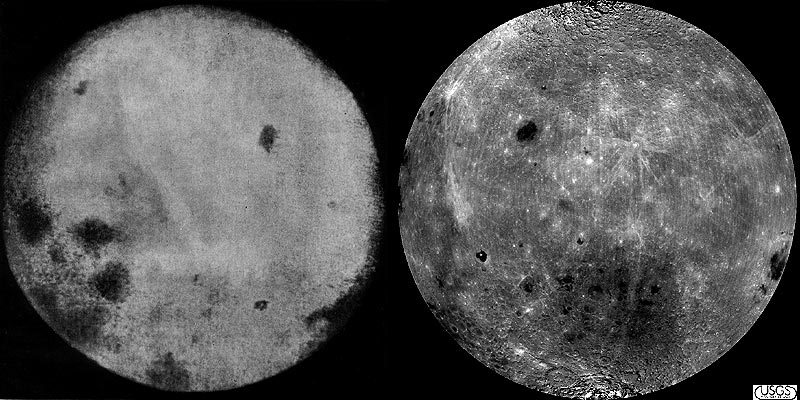Difference between revisions of "January 14, 2004"
| (11 intermediate revisions by the same user not shown) | |||
| Line 1: | Line 1: | ||
__NOTOC__ | __NOTOC__ | ||
=First and Last= | =First and Last= | ||
| + | <!-- Start of content --> | ||
<table width="85%" border="0" align="center" cellpadding="6" cellspacing="2"> | <table width="85%" border="0" align="center" cellpadding="6" cellspacing="2"> | ||
<tr> | <tr> | ||
| Line 11: | Line 12: | ||
<table width="100%" border="0" cellpadding="8"> | <table width="100%" border="0" cellpadding="8"> | ||
<tr> | <tr> | ||
| − | <td><div align="center" span class="main_sm">Image Credit: | + | <td><div align="center" span class="main_sm"><p>Image Credit: |
[http://nssdc.gsfc.nasa.gov/imgcat/html/mission_page/EM_Luna_3_page1.html NSSDC] and | [http://nssdc.gsfc.nasa.gov/imgcat/html/mission_page/EM_Luna_3_page1.html NSSDC] and | ||
| − | [http://astrogeology.usgs.gov/Projects/Clementine/index.html USGS] | + | [http://astrogeology.usgs.gov/Projects/Clementine/index.html USGS]</p> |
</div></td> | </div></td> | ||
</tr> | </tr> | ||
| Line 29: | Line 30: | ||
center is Tsiolkovskiy. And finally, the largest, mottled dark area bottom center-right on the Clementine image is the | center is Tsiolkovskiy. And finally, the largest, mottled dark area bottom center-right on the Clementine image is the | ||
South Pole-Aitken Basin. | South Pole-Aitken Basin. | ||
| + | </p> | ||
<p class="story"><b>Related Links:</b><br> | <p class="story"><b>Related Links:</b><br> | ||
[http://nssdc.gsfc.nasa.gov/database/MasterCatalog?sc=1959-008A Luna 3]<br> | [http://nssdc.gsfc.nasa.gov/database/MasterCatalog?sc=1959-008A Luna 3]<br> | ||
[http://astrogeology.usgs.gov/Projects/Clementine/index.html Clementine]</p> | [http://astrogeology.usgs.gov/Projects/Clementine/index.html Clementine]</p> | ||
| − | <p | + | <p><b>Yesterday's LPOD:</b> [[January 13, 2004|Apollo 15 Panned]] </p> |
| + | <p><b>Tomorrow's LPOD:</b> [[January 15, 2004|Gassendi Compared]] </p> | ||
</table> | </table> | ||
<!-- start bottom --> | <!-- start bottom --> | ||
| Line 42: | Line 45: | ||
<td><p align="center" class="main_titles"><b>Author & Editor:</b><br> | <td><p align="center" class="main_titles"><b>Author & Editor:</b><br> | ||
[mailto:tychocrater@yahoo.com Charles A. Wood]</p> | [mailto:tychocrater@yahoo.com Charles A. Wood]</p> | ||
| − | < | + | <!-- Cleanup of credits --> |
| − | + | <!-- Cleanup of credits --> | |
| − | < | + | <!-- Cleanup of credits --> |
| − | + | <!-- Cleanup of credits --> | |
| − | < | + | <!-- Cleanup of credits --> |
| − | + | <!-- Cleanup of credits --> | |
| + | <!-- Cleanup of credits --> | ||
</tr> | </tr> | ||
</table> | </table> | ||
| Line 53: | Line 57: | ||
<div align="center"></div> | <div align="center"></div> | ||
<p> </p> | <p> </p> | ||
| − | ---- | + | <!-- End of content --> |
| − | + | {{wiki/ArticleFooter}} | |
| − | |||
Latest revision as of 19:10, 7 February 2015
First and Last
|
First and Last In 1959 the Soviet probe Luna 3 swept behind the Moon and took the first photograph (left) of the lunar farside (in fact, the first picture EVER of any extraterrestrial planetary body from space). And the most recent image of the lunar farside is this (right) mosaic of Clementine frames acquired in 1994. Other than some Apollo and Lunar Orbiter photos, the farside, almost as alien as a tenth planet, remains little imaged and little studied. The extensive areas of brightness across the Luna picture demonstrate that the farside has far less maria (dark) than the lunar nearside. The patches of darkness at the lower left of the the Luna image are the mostly frontside maria Crisium, Marginis, Smythii and Fecunditatis - none of which show up on the Clementine mosaic. The isolated dark patch in the upper right of the Luna view is Mare Moscoviense - also seen left of center on the right image. The small black spot with a white dot in the center is Tsiolkovskiy. And finally, the largest, mottled dark area bottom center-right on the Clementine image is the South Pole-Aitken Basin. Related Links: Yesterday's LPOD: Apollo 15 Panned Tomorrow's LPOD: Gassendi Compared |
Author & Editor: |
COMMENTS?
Register, Log in, and join in the comments.




